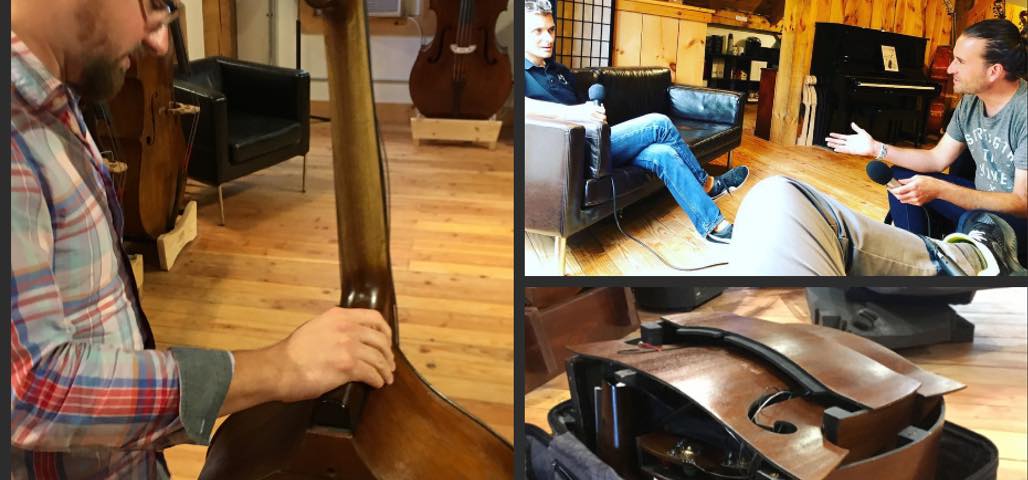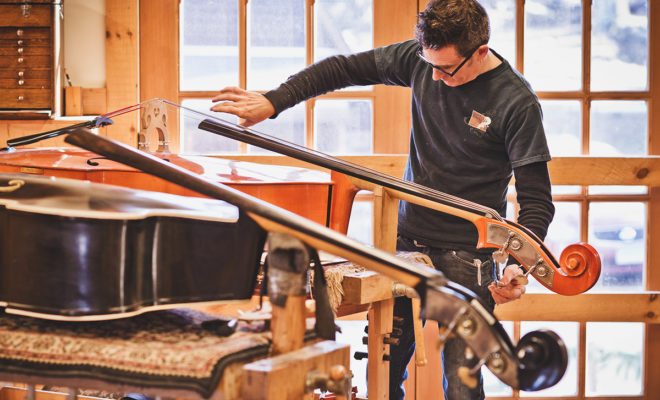I’ve been a fan of Upton Bass ever since discovering them online back in the early 2000s. One of my private students had purchased an Upton bass, and I thought that it played great and was quite reasonably priced. I was intrigued for sure.
It has been so cool watching them grow and evolve over the years. In addition to making the transition into building all their own instruments in their Mystic, Connecticut shop, they’ve been remarkably effective at building a loyal following of raving fans.
They’ve also been longtime supporters of my projects, sponsoring the blog and podcast back in the “dark ages” around 2007. They came back onboard as a sponsor after I relaunched the podcast in 2015, and it has been great to see them continue to evolve their craft.
Though I’ve played a bunch of Upton basses over the years, I’d never actually made the trip to the Upton Bass barn… until now!
My Trip to Upton Bass
I hopped Amtrak from New York City to Mystic, and Eric Roy picked me up at the train station. Not only had I never been to Mystic, but I’d barely spent any time in New England at all, and I was struck by how charming this quaint seaside vacation town looked.
Eric gave me a tour of the town, and we crossed the drawbridge into the main drag and up into the rolling hills to the Upton Bass barn.
This place does not disappoint! It’s certainly the most picturesque bass shop setting that I’ve ever visited, located in the Burnett’s Corner of Old Mystic.
Gary and company did a traditional barn raising in August 2012, with the workshop moving in during October.
Eric took me into the wood seasoning shed just outside of the barn. Wood lives in here for several years prior to being used for bass building.
Upon entering the barn, I saw three basses being built next to each other. One was a laminate, while the others were hybrid and fully-carved. The same level of care was being given to the workmanship of the laminate bass as the fully-carved. This is not the case everywhere!
Next to each bass was a “patient chart” of sorts for each instrument, with details about the instrument specifications. Everything was neat and orderly, with backs, tops, and ribs labeled with the new bass owner’s name. I got a kick out of seeing the bass parts for the newly commissioned bass from Contrabass Conversations podcast producer Trevor Jones, one of my longtime bass friends!
As we toured the shop, Eric and I were talking about the concept of “B stock,” and how Upton doesn’t believe in B stock. There is no B stock used in instrument building—anything that is considered B stock is tossed.
The challenge of working with wood, of course, is that you’re dealing with an unpredictable organic material, and you don’t know exactly whet you’re going to find when you start building an instrument. You might spend hours and hours working a piece of wood, only to find a knot or other defect appearing. At that point, you’re faced with a choice: keep or toss? Upton will toss the wood with the defect, even after all those hours poured into the instrument.
Upton has five luthiers working alongside Eric Roy, turning out their various models like the Concord, Brescia, Mittenwald, Bostonian, Karr, and Bohemian. We dug into the specifics of many of these models and how they evolved during our podcast interview.
We headed upstairs to the bass showroom, which was filled with all sorts of Upton basses and vintage basses. Several customers came and went during my visit, some trying out basses and others bringing in their instrument for some repair and setup work by the Upton guys.
Gary Upton arrived soon after we went upstairs, having just teaching a spin class at his gym UP.Fitness. Yes, Gary also owns a gym… and he and Eric Roy are both spin instructors there as well!
The Suitcase Bass
After having a great hourlong chat for the podcast, Gary broke out the item that I’d been waiting to check out in person for months: Upton’s new prototype Suitcase Bass.
Here’s a video of Gary setting this bass up:
I was blown away. I mean, this instrument actually folds up to fit inside of a regular Samsonite suitcase! It starts off as a fully-assembled 3/4 size bass, and it comes apart piece by piece and fits together in this remarkable small package.
This about the possibilities… think about how travel would be if you didn’t have to lug around a big trunk on the road but still have a fully acoustic bass with the size of body to which you’re accustomed.
Naturally, I posted a bunch of photos of this to social media, with the expected question resulting: “where is this going to be available?”
They’re prototyping the bass now and doing some road tests. Clearly, this is a bold new direction in bass design, and Upton, like any company with a new product like this, is looking to refine the design as they move forward. I’m totally pumped about this design, and I can’t wait to see it out there!
View this post on Instagram
The @uptonbass suitcase bass, deconstructed #uptonbass #doublebass #travelbass
After chatting for the podcast and seeing the Suitcase Bass in action, Gary and I headed out for some lunch and to talk International Society of Bassists business. We’re both on the ISB board, and I learn so much every time I talk with him about business, the bass world, innovation, and harnessing technology.
What a great trip, and what a great crew at Upton Bass. I can’t believe that it took me so long to get up to Mystic, and I can’t wait to visit again soon!
Learn More
Check out some of our past podcasts with folks that own an Upton Bass or have had their bass worked on by Upton:
- Eric Revis – Branford Marsalis band
- Kevin Smith – Willie Nelson band
- Tony Manzo – Chamber Music Society of Lincoln Center
- David White – Broadway musician
- Marc Ramirez – Bassist in Lisbon, Portugal
- Lucia Turino – The Devil Makes Three
- Trevor Jones – Chicago musician and Contrabass Conversations producer
Bass News Right To Your Inbox!
Subscribe to get our weekly newsletter covering the double bass world.


